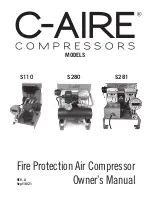
4
5
LUBRICATION OF COMPRESSOR
Before attempting to operate this air compressor the
transport plug must be removed, thrown out and replaced
with the oil breather. Check the oil level to ensure the level
is to the top of the red dot on the sight glass; refer to page
10 for complete details and diagram. Failure to do this may
result in damage to the air compressor and / or injury to the
user.
PLEASE follow the instructions noted on page 10 on
replacing the transport plug to the oil breather.
ASSEMBLY
This compressor MUST be fully assembled by you prior to
use. Failure to do so will result in the warranty being VOID.
Failure to fully assemble this compressor may also result in
personal injury.
MANOEUVRING
When moving this air compressor always use the handle to
lift slightly and pull/push using the attached wheels. If you
must lift this air compressor always use a 2 person lift due
to its weight and size. Failure to use 2 person lift may result
in personal injury.
SAFETY
Before attempting to operate this air compressor the
following basic safety precautions should be taken to
reduce the risk of fire, electric shock and personal injury.
It is important to read the instruction manual and to
understand applications, limitations and potential hazards
associated with the air compressor. This air compressor
is not intended for use by persons (including children)
with reduced physical, sensory or mental capabilities, or
lack of experience and knowledge, unless they have been
given supervision or instruction concerning the use of the
appliance by a person responsible for their safety.
BEWARE OF CHILDREN AND PETS
Children and pets should be kept out of the work area. Children
should not be allowed to touch or operate the air compressor,
tools or extension cords. This air compressor is not designed
for use by young children or infirm persons without supervision.
The air compressor and tools should be kept out of reach of
children, preferably stored or locked in a secure cabinet or room
when not in use.
WORK AREA
Work areas and benches should be kept tidy. Cluttered
benches and work areas can cause accidents. Floors should
be kept clean and free from rubbish. Special care should
be taken when the floor is slippery due to sawdust or wax.
Always leave sufficient distance, at least 5 metres between
the air compressor and the work area, especially when using
tools designed for sanding or spraying liquids.
WORK ENVIRONMENT
Do not expose your air compressor to rain or use in damp
or wet conditions. Keep the work area well lit. Always
ensure your compressor is level and stable. Using your
compressor on unlevel or unstable ground may cause a lack
of lubrication and the pump to seize, this damage will not be
covered under warranty.
GUARD AGAINST ELECTRIC SHOCK
Avoid body contact with earthed or grounded surfaces (e.g.
pipes and refrigerators).
DO NOT OVERLOAD AIR COMPRESSORS
The air compressor will do a better, safer job and give you
much better service if it’s used at the duty cycle for which
it was designed. The duty cycle will only take effect after
the initial (1st ) tank fill for the day. This air compressors duty
cycle is 75%. Duty cycle is the proportion of time during which
the air compressor is operated. This means after 45 seconds
of operation, motor pumping, the air compressor must be left
for 15 seconds resting, motor not pumping. When the motor
is pumping the attached air tool can not be used. Only use the
attached air tool while the compressor is not pumping. Stop
using the attached tool as soon as the air compressor starts
pumping.
USE THE RIGHT TOOL
Select the right tool for the job. Do not use a tool for a job
for which it was not designed. Do not force a small air
compressor to do the job of a heavy–duty air compressor.
Do not use the air compressor for purposes not intended.
Summary of Contents for BR105D
Page 19: ...19 NOTES...






































